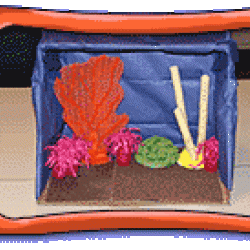Source Institutions
Source Institutions
Add to list Go to activity
Activity link broken? See if it's at the internet archive

Educator Amy O'Donnell from the American Museum of Natural History guides learners to create a diorama of a coral reef. Learners will use craft skills to transform household materials into simulated brain coral, sea fans, sea anemones, and a sponge. This resource contains background information about coral and the use of dioramas in museums. Also includes extension ideas.
- Under 5 minutes
- 1 to 2 hours
- $5 - $10 per student
- Ages 6 - 14
- Activity, Model
- English
Quick Guide
Materials List (per student)
- cardboard box, approximately 2' x 1'
- blue tissue paper or blue construction paper (or even newspaper painted blue)
- clear tape
- a few pieces of sandpaper OR paper, sand, and glue
- scissors
- bag of "radiatore" pasta; it has a ruffled, ridged shape
- ball of modeling clay, Model Magic, or Play-Doh
- paint, green, yellow, and brown
- paint brushes
- plastic cups or bowls for paint
- cup of water, for cleaning brushes
- newspaper, to put on table before painting
- sheet of white (plain) needlepoint canvas
- pipe cleaners, thick (orange, red, yellow, pink or purple)
- pipe cleaners, thin (orange, red, yellow, pink, or purple)
- paint, orange, red, yellow, pink, or purple
- a bag of hair curlers (or cardboard paper towel or toilet paper rolls)
- pink or red plastic pom-poms, or red construction paper cut into thin strips, or pink Easter grass
- about 6 to 10 tan-colored plastic hair curlers (the kind that have two parts)
- yellow Play-Doh
Subjects
-
Earth and Space Science
-
Earth Structure
- Oceans and Water
-
Earth Structure
-
Life Sciences
-
Diversity of Life
- Plants
- Animals
-
Ecology
- Ecosystems
-
Diversity of Life
-
The Nature of Science
- Science as a Career
Informal Categories
- Animals
- Arts and Crafts
- Model Building
Audience
To use this activity, learners need to:
- see
- see color
- touch
Learning styles supported:
- Links STEM to other topics of interest such as arts and humanities
- Involves hands-on or lab activities
Other
Components that are part of this resource:
This resource is part of:
Access Rights:
- Free access
By:
Source Collection
- Ology
Rights:
- All rights reserved, American Museum of Natural History,
